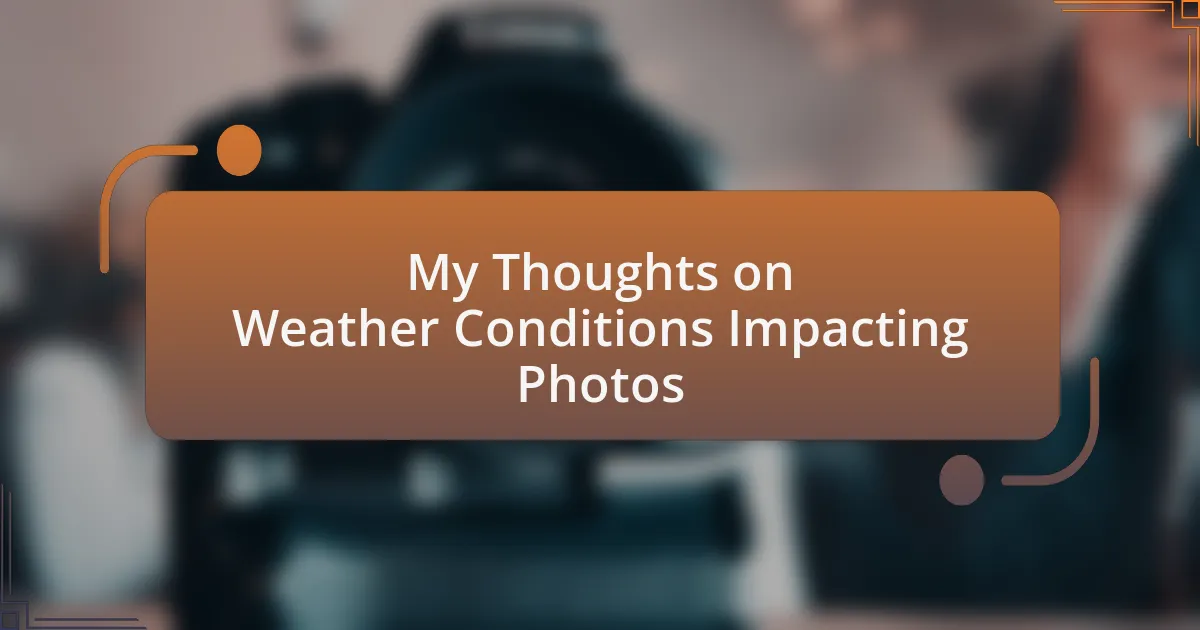Key takeaways:
- Weather significantly influences photography, transforming scenes and evoking emotions.
- Different atmospheric conditions, like fog or dramatic sunsets, add narrative depth to images and enhance storytelling.
- Light quality varies with weather, affecting textures, ambiance, and emotions captured in photographs.
- Extreme weather can challenge photographers, pushing creativity and adaptability in capturing compelling shots.
Author: Clara Ashton
Bio: Clara Ashton is a contemporary fiction author known for her evocative storytelling and richly drawn characters. With a degree in English Literature from the University of California, Berkeley, Clara combines her passion for writing with a deep understanding of narrative structure. Her debut novel, “Whispers of the Forgotten,” received critical acclaim for its poignant exploration of love and loss. Clara’s work has been featured in several literary journals, and she regularly contributes essays on the writing process. When she’s not crafting her next tale, Clara enjoys hiking in the Pacific Northwest and sipping artisanal coffee in local cafes. She currently resides in Portland, Oregon, with her two rescue dogs, Max and Bella.
Understanding weather impacts on photography
Weather plays a crucial role in photography, shaping not just the scenes we capture but also the emotions they evoke. I remember a rainy day when I decided to take my camera out. As the raindrops began to dance on the leaves, the vibrant colors popped in a way I hadn’t anticipated. Do you ever think about how different weather conditions can transform a mundane landscape into a dramatic masterpiece?
Cloud cover can soften harsh sunlight, providing an even light that’s perfect for capturing details. One overcast afternoon, I was wandering through a forest. The diffused light created an ethereal atmosphere, highlighting the subtle textures of the bark and the delicate shapes of the leaves. It’s moments like these that remind me how adaptable we must be as photographers; every weather condition offers a unique opportunity.
On the other hand, extreme weather can pose challenges, too. I once shot a photo during a snowstorm that made the world feel both serene and chaotic. I had to work quickly, battling against the wind and snow to capture that fleeting moment of beauty. How do you adapt your shooting techniques in the face of unpredictable weather? Embracing these challenges can lead to unexpected and stunning results.
Importance of weather in photography
Weather isn’t just a backdrop; it can be the soul of a photograph. I vividly recall a particularly foggy morning when I ventured out to capture a local bridge. The mist wrapped around the structure, creating a mysterious vibe that transformed an otherwise ordinary scene into something magical. Have you ever considered how atmospheric conditions can evoke certain feelings in your photos?
Each weather pattern tells a different story. I once took my camera to the beach during a dramatic sunset, with storm clouds swirling in the distance. The contrasting light—golden sunlight filtering through the dark clouds—made for a breathtaking composition that didn’t just illustrate the beauty but also the raw power of nature. Moments like these emphasize how weather can enhance the narrative within your images.
Conversely, extreme weather can test your limits and creativity. I remember a windy day at a nature preserve where I was capturing wildlife in motion. The gusts would abruptly change the scene, rustling leaves and altering light conditions, compelling me to think quickly and adjust my settings on-the-go. Isn’t it fascinating how unpredictable weather forces us to be more dynamic in our approach? Embracing these unpredictable elements often leads to some of the most compelling shots in our portfolios.
Effects of light on photos
Light is the invisible thread that weaves the fabric of a photograph, and its quality can change dramatically depending on the weather. I remember a late afternoon shoot when the sun peeked through a layer of clouds, casting a soft, diffused glow on the landscape. The interplay of light and shadow not only highlighted the textures of the scene but also created an intimate ambiance, drawing viewers into the moment. Have you noticed how different times of day transform the way light dances across your photos?
On a different occasion, I found myself shooting during a snowstorm. The heavy snowfall muted all harsh light, resulting in a serene, almost monochromatic palette. It was fascinating how this soft lighting turned mundane objects into ethereal forms, making everything feel dreamlike. This experience reminded me that while bright light has its charm, softer conditions often evoke deeper emotions. Don’t you find that some of your most striking images come from unusual lighting scenarios?
Then there are those moments when the golden hour arrives, infusing your subjects with a warm, inviting radiance. I distinctly recall capturing a portrait of a friend as the sun set behind them, enveloping them in a halo of golden light. This magical effect not only brought out their features but also created a sense of warmth and connection. Isn’t it incredible how a shift in light can elevate a simple portrait into something deeply meaningful?
